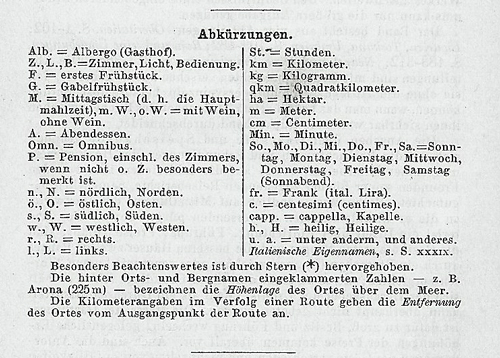Baedeker | Murray
( words)
Baedeker and Murray developed the guide book, Badeker invented the first "Star rating system".
Baedeker, the son of a book printer, was born in Essen, then in the Kingdom of Prussia, and started his publishing company in 1827 in Koblenz. Baedeker's company in 1832 bought another Koblenz publisher (Friedrich Röhling) which had in 1828 published a handbook for travellers by J. A. Klein, under the title Rheinreise von Mainz bis Köln (travelling the Rhine from Mainz to Cologne). This provided the basis for the first of the Baedeker travel guides.
 Abrevations used by Baedeker (you can enlarge the picture by opening it in a new window) included the "star", an asterix.
Abrevations used by Baedeker (you can enlarge the picture by opening it in a new window) included the "star", an asterix.
 In Rome, Baedeker gave his star to various top hotels, among them to the Hotel de Russie and to the Grand Hôtel. The Swiss Manager was - by the way - Alphonse Pfyffer, the son of Colonel Pfyffer (Grand Hotel National, Luzerne; you can enlarge the picture by opening it in a new window). These hotels were outstanding and received one star as a special accolade. The star was simply placed in front of the hotel's name.
In Rome, Baedeker gave his star to various top hotels, among them to the Hotel de Russie and to the Grand Hôtel. The Swiss Manager was - by the way - Alphonse Pfyffer, the son of Colonel Pfyffer (Grand Hotel National, Luzerne; you can enlarge the picture by opening it in a new window). These hotels were outstanding and received one star as a special accolade. The star was simply placed in front of the hotel's name.
 Destinations and their touristic sights often received two stars. The Gallery Uffizi in Florence, for example (enlarge the picture by opening it in a new window).
Destinations and their touristic sights often received two stars. The Gallery Uffizi in Florence, for example (enlarge the picture by opening it in a new window).
The red bindings and gilt lettering soon became the familiar hallmark of Baedeker's guides, and the content became famous for its detail and accuracy. While the travel guide was not a new form, Baedeker's innovation was to include specific details of transportation, accommodations, prices, and so forth. Starting in 1844, he augmented this with star ratings for attractions. Baedeker was famous for his careful work; when visiting Milan Cathedral in 1847, he was observed to drop a pea at every twenty steps of the staircase to the roof, so as to be able to report the number of steps accurately (as reported Freiherr Karl Gisbert Friedrich von Vincke).
His brother Frederick Baedeker (1823-1906), who joined the Plymouth Brethren movement, was also well travelled. Early in his career he sailed to Australia following professional pursuits and after 1866 in Christian service travelled to Sweden, Russia and Siberia, preaching to prisoners and aristocracy.

Eight years prior to Baedeker, in 1836, John Murray published the first 'Handbook for Travellers' guide and along with the famous Baedeker series, they were one of the first examples of travel guide books ever made.  The style and format of the books inspired the design of many imitators, and the influence of Murray's Handbooks can still be seen in modern guidebooks. They became one of John Murray's most popular series of books and could be compared to the 'Rough Guide' or 'Lonely Planet' series today. They weren't just similar in terms of popularity – the handbooks were very similar in content too! Murray's books, too, were designed to be used (two differently coloured reading marks, soft but stabile cover, thin = light paper). The Scottish National Library holds one of the largest selections of Murrays in the world.
The style and format of the books inspired the design of many imitators, and the influence of Murray's Handbooks can still be seen in modern guidebooks. They became one of John Murray's most popular series of books and could be compared to the 'Rough Guide' or 'Lonely Planet' series today. They weren't just similar in terms of popularity – the handbooks were very similar in content too! Murray's books, too, were designed to be used (two differently coloured reading marks, soft but stabile cover, thin = light paper). The Scottish National Library holds one of the largest selections of Murrays in the world.
Also read: Baedeker's universe
Also read: Worth the Detour - A History of the Guidebook
____________________






